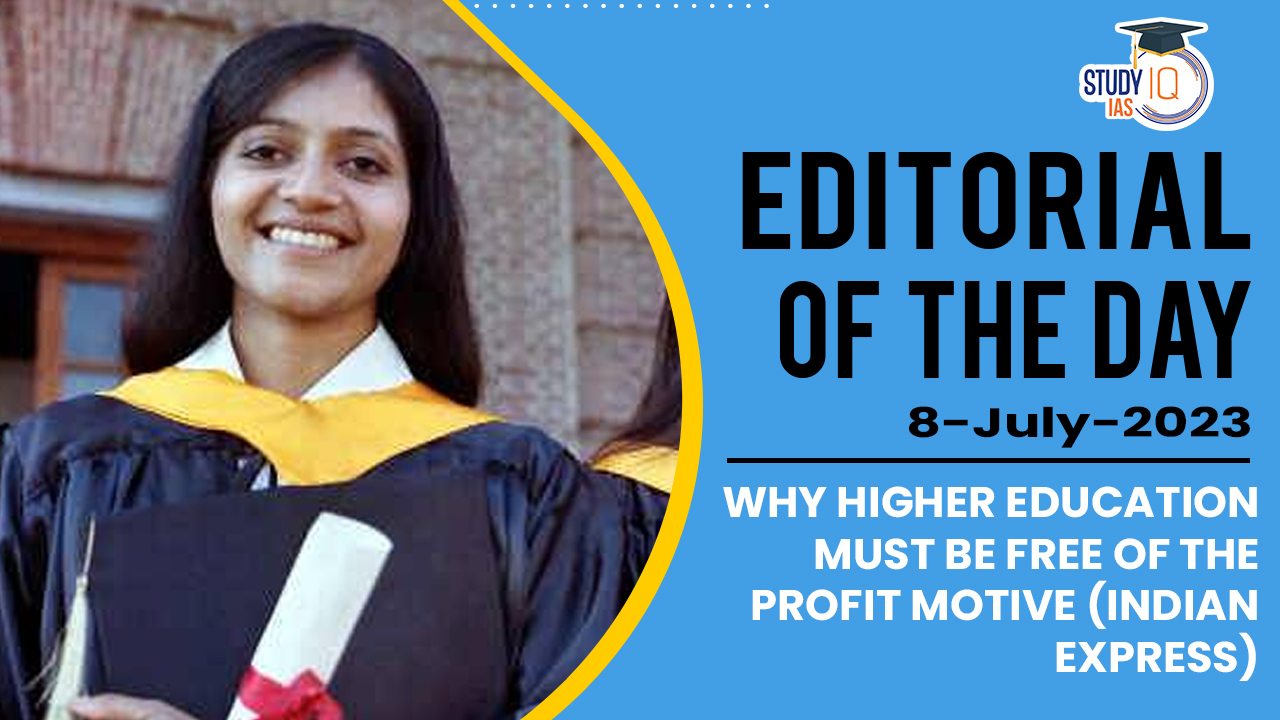Table of Contents
Context: The article is discussing the state of higher education institutions in India and the challenges they face in terms of productivity, accountability, and management. It highlights the dissatisfaction regarding Indian higher education institutions and attributes it to the absence of corporate practices in public universities. It emphasizes that exceptional private universities offer better job security and facilities for faculty, ensuring quality education. It lays emphasis on the fact that universities should cater to the knowledge market by generating and expanding knowledge through teaching and research. Overall, the article explores the complexities and challenges of the higher education system in India, touching upon issues of management, funding, quality, and the role of market forces in shaping educational outcomes.
Background
Higher Education in India:
- The term ‘higher education’ with respect to India denotes the tertiary level education that is imparted after 12 years of schooling (10 years of primary education and 2 years of secondary education).
- India’s higher education system is the third largest in the world, next to the United States and China.
- India’s Higher Education sector has witnessed a tremendous increase in the number of Universities/University level Institutions & Colleges since independence.
- As per the All-India Survey of Higher Education (AISHE), there are 1,043 universities, 42,343 colleges and 11,779 standalone institutions.
- Out of these, almost 78.6% are in the private sector– aided or unaided colleges and only about 21% are in the Government sector.
- Key findings of All India Survey on Higher Education (AISHE) 2020-2021:
| Specification | 2020-21 | Trend w.r.t 2014-15 |
| Total student enrollment: UP, Maharashtra, TN, MP, Karnataka and Rajasthan are top 6 States in terms of number of students enrolled | 4.14 crore | 21% rise |
| Female enrolment | 2.01 crore | 28% rise |
| Percentage of female enrolment to total enrolment | 49% | 4% rise |
| Gross Enrolment Ratio (GER): Percentage of students belonging to eligible age group (18-23 years) enrolled in Higher Education | 27.3 | 3-point rise |
| Gender Parity Index (GPI): Ratio of female GER to male GER | Increased from 1 in 2017-18 to 1.05 | — |
| Institutes of National Importance (INIs) | 149 | Almost doubled (75) |
| Enrolment in INIs | 61% | Increased |
| Female per 100 male faculty | 75 | Increased (63) |
Issues plaguing India’s Higher Education:
- Shortage of Faculty: Colleges and universities need a sufficient number of teachers and researchers to create and disseminate knowledge. The paucity of a sufficient number of faculty members undermines the growth of India’s knowledge sector.
- There is no standing mechanism to collect the information shortage of faculties.
- Sometimes positions of faculties also remain vacant due to caste-based discrimination.
- Diversity of teachers: In central universities (CUs), 75.2% of the sanctioned SC posts, 87.3% of the ST positions and 84.7% of the OBC posts for the position of professor are lying vacant, while in the associate professor category it is 64.7%, 76.8% and 76.6% respectively.
- Shortage of PhD scholars: As per data of Lok Sabha, in 9 IITs, the acceptance rate for SC/ST/OBC PhD candidates is at or below 8%, despite all of these universities receiving hundreds of applications. The dropout trends from these premium educational institutions have been from SC/ST/OBC categories.
- Low GER: In India, currently, the gross enrolment ratio for Higher Education is less than 30%.
- Overburdening faculty: As a result of faculty shortage, professors are being overburdened. Their working hours have increased.
- Lack of Financial Resources: Public spending on education has been relatively low in India since its inception. Most states spend 2.5 to 3.2% of their GDP on education.
- Poor Quality of Education: Many private universities whose primary purpose is profit-seeking hire less qualified people in poorly paid part-time positions as faculties instead of better qualified, regular faculty members, to keep costs down.
- Commercialization: The withdrawal of the public sector has left the space open for private institutions that have turned education into a flourishing business.
- Curriculum Disparity: There is a wide gap between industry requirements and curriculum taught at colleges. This also renders graduates unemployable lacking in specific skill-sets.
- Poor Research infrastructure: India’s spending on research and development (R&D) is among the lowest in the world.
- Only 2.7% Colleges run Ph.D. programme and 35.04% Colleges run Post-Graduate Level programmes in India.
- Under-representation of Women: India’s best educational institutions rank quite poorly in women diversity. The scores have been dismal in India’s top 10 engineering institutes.
- Lack of Autonomy: The over-regulation by regulators such as UGC, MCI, which decide on aspects of standards, appointments, fee structure and curriculum has further deterred new institutions from opening campuses.
Decoding the Editorial
The article is discussing the state of higher education institutions in India and the challenges they face in terms of productivity, accountability, and management.
- It highlights the dissatisfaction expressed by experts and academia regarding Indian higher education institutions and attributes it to the absence of corporate practices in public universities.
- The author offers a different perspective by discussing private institutions and their shortcomings, such as a mechanical management model, reliance on routine teaching at low rates, and limited focus on research.
- It is expressed that exceptional private universities offer better job security and facilities for faculty, ensuring quality education.
- The historical funding mechanisms for public universities were based on performance and project-based schemes, leading to disparities in standards. The decline in the status and funding of public universities is attributed to the professional classes opting for privatized higher education.
- The concept of “market forces” has been mentioned by the authors where demand for training aligned with the job market is considered.
- It is argued that universities should cater to the knowledge market by generating and expanding knowledge through teaching and research. Knowledge centres should uphold rigorous standards of productivity and accountability but should not be operated like a consumerist market or gig economy.
- The article highlights the importance of self-regulation within the education system. It mentions the potential drawbacks of excessive regulation in teaching appointments and syllabus design.
- The author concludes by posing the question of whether the current system, despite its flaws and regulations, provides better opportunities for students to acquire knowledge and lead fulfilling lives compared to a potentially chaotic but unregulated order.
Beyond the Editorial
Government Initiatives for Improving Higher Education:
- National Education Policy (NEP) 2020: It proposes various reforms in India’s higher education including technical education.
- NEP aims to increase the gross enrollment ratio (GER) in higher education to 50% by 2035.
- The Institute of Eminence (IoE): It is a recognition scheme under University Grants Commission (UGC) that helps empower higher educational institutions. The HRD Ministry of India grants the Institution of Eminence status to multiple universities.
- Academic institutions that can impart highest quality education, generate cutting edge research, and attract the best and the brightest from across the globe can have multiplier beneficial effects for the country.
- Rashtriya Uchchatar Shiksha Abhiyan (RUSA): It is a Centrally Sponsored Scheme (CSS) that aims at providing strategic funding to eligible state higher educational institutions.
- Education Quality Upgradation and Inclusion Programme (EQUIP): This is a five-year vision plan to improve the quality and accessibility of higher education over the next five years (2019-2024).
- Double the Gross Enrolment Ratio (GER) in higher education and resolve the geographically and socially skewed access to higher education institutions in India.
- Position at least 50 Indian institutions among the top-1000 global universities.
- Global Initiative for Academics Network (GIAN): The programme seeks to invite distinguished academicians, entrepreneurs, scientists, experts from premier institutions from across the world, to teach in the higher educational institutions in India.
- All India Survey on Higher Education (AISHE): The main objectives of the survey are to identify and capture all the institutions of higher learning in the country; and collect the data from all the higher education institutions on various aspects of higher education.


 Daily Quiz 14 April 2025
Daily Quiz 14 April 2025
 UPSC Syllabus 2025, Check UPSC CSE Sylla...
UPSC Syllabus 2025, Check UPSC CSE Sylla...
 EU Plans to Slash General Data Protectio...
EU Plans to Slash General Data Protectio...





















